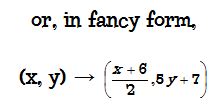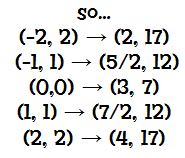So the perfect storm happened at TMC. In case you missed it (because it was only in my head), here’s what happened:
1) I had an algebraic epiphany last month about using flowcharts to solve equations:
 At the very end, I had an inkling of an idea to tie it into function transformations:
At the very end, I had an inkling of an idea to tie it into function transformations:
but I didn’t really know where to go from there or if it was a viable way to think about it.
2) I had a conversation with two people about how confusing it must be for kids to do transformations in Geometry where x + 2 means “move two to the right,” then move to algebraic transformations where seeing f(x +2) means “move two to the left.” We wondered how we could make the transition easier for students, but came up with nothing. (Side note: I can picture sitting at a table with a boy and a girl having this conversation, but I cannot picture the boy and the girl. I’m now thinking it was not at TMC, but maybe another workshop I was at this summer? But if you are reading this and it was you, let me know so it doesn’t keep me up nights anymore.) (Further side note: Um, somehow I never taught transformations in Geometry? Is that weird?)
3) I worked with Sheri Walker (@sheriwalker72) in the Going Deeper with Desmos morning session. We were tasked with making a new lesson using Desmos and she immediately turned to me and came up with an awesome idea because she knew that we both loved function transformations (who doesn’t, amirite?). I also brought in a copy of my handouts from my session to share with her and then she just casually mentions how she approached function transformations and jots down something like this for the equation y = 5|2x – 6| + 7:
 (I know, it’s weird that her handwriting is the same as the Chowderhead font, but that’s just how cool she is.)
(I know, it’s weird that her handwriting is the same as the Chowderhead font, but that’s just how cool she is.)
Ok, so at this point I begin freaking out because Sheri can obviously read minds. I mean, I just had this epiphany three weeks ago. So I was so amazed at her mind-reading ability that it was not until later that I realized the elegance and awesomeness of her next step.
Are you ready?
I really think you should be sitting down.
If you’re reading this on a tablet, make sure you have a soft spot for it to land when you drop it.
Maybe alert your in-case-of-emergency contact.
Here it is…
 Ok, she called it something other than “fancy form” (programming form? transformation form? input/output form?) but you get the idea. Or maybe you’re like me and you think it’s pretty but “getting the idea” will suddenly hit you three hours later. SHE JUST TIED ALGEBRAIC AND GEOMETRIC TRANSFORMATIONS TOGETHER.
Ok, she called it something other than “fancy form” (programming form? transformation form? input/output form?) but you get the idea. Or maybe you’re like me and you think it’s pretty but “getting the idea” will suddenly hit you three hours later. SHE JUST TIED ALGEBRAIC AND GEOMETRIC TRANSFORMATIONS TOGETHER.
Added bonus? No more worrying about whether the form is in f(bx – h) or f(b(x -h), because this takes care of that. Want to see it action? Let’s take that same equation, y = 5|2x – 6| + 7. Except this time, let’s just find (x, y) pairs from the original absolute value function and use the fancy form to transform them:

 What? That just happened. Are you as amazed as I was? Now pondering how to fit this in to my already over-long function transformations unit….
What? That just happened. Are you as amazed as I was? Now pondering how to fit this in to my already over-long function transformations unit….








